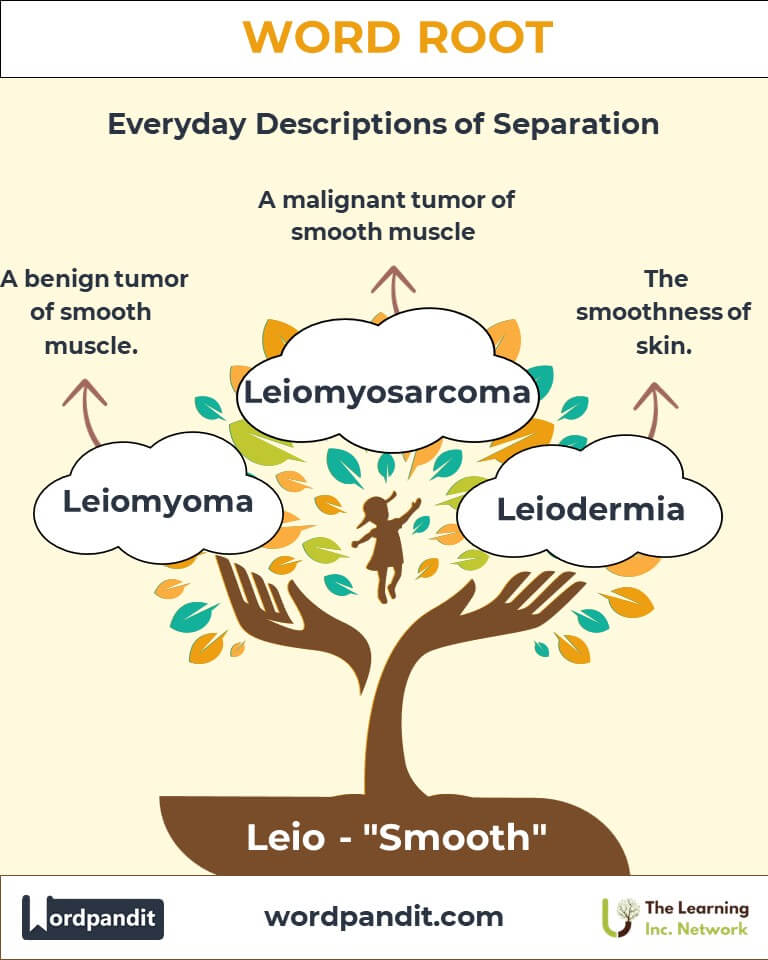Leio: The Root of Smoothness in Science and Language
Explore the fascinating word root "leio," derived from Greek, meaning "smooth." This root is central to terms in medicine, biology, and beyond, such as "leiomyoma" (a smooth muscle tumor) and "leiotrichous" (having smooth hair). Unveiling its origins and applications highlights the elegance of smoothness in language and science.

Table of Contents
- Introduction: The Essence of "Leio"
- Etymology and Historical Journey
- Mnemonic: Unlocking the Power of "Leio"
- Common "Leio"-Related Terms
- "Leio" Through Time
- "Leio" in Specialized Fields
- Illustrative Story: "Leio" in Action
- Cultural Significance of "Leio"
- The "Leio" Family Tree
- FAQs about the "Leio" Root
- Test Your Knowledge: "Leio" Mastery Quiz
- Conclusion: The Smooth Legacy of "Leio"
1. Introduction: The Essence of "Leio"
Pronounced "lee-oh," the root "leio" signifies smoothness, capturing both physical texture and metaphorical fluidity. Derived from Greek, it serves as the cornerstone of terms that celebrate this quality, particularly in medical and biological contexts. Smooth muscles, smooth surfaces, and even smooth expressions owe their terminology to this elegant root.

2. Etymology and Historical Journey
The word root "leio" originates from the ancient Greek word leios, meaning "smooth." Early Greek physicians applied it to describe muscles lacking the striations of skeletal muscle. As scientific language evolved, "leio" was incorporated into Latin and later English, enriching terms that convey the essence of smoothness across disciplines.
3. Mnemonic: Unlocking the Power of "Leio"
Visualize the gentle ripple of a silk ribbon gliding through the air—its smooth texture embodies the essence of "leio."
Mnemonic Device: "Leio, like silk, is smooth and sleek."
4. Common "Leio"-Related Terms
- Leiomyoma (lee-oh-my-oh-mah): A benign tumor of smooth muscle.
Example: "The patient underwent surgery to remove a leiomyoma from her uterus." - Leiotrichous (lee-oh-trik-us): Having smooth, straight hair.
Example: "Leiotrichous individuals are often admired for their glossy, straight locks." - Leiomyosarcoma (lee-oh-my-oh-sar-coh-mah): A malignant tumor arising from smooth muscle.
Example: "Leiomyosarcoma is a rare but aggressive form of cancer." - Leiodermia (lee-oh-der-mee-ah): Smoothness of the skin.
Example: "Leiodermia is a common goal in cosmetic dermatology."
5. "Leio" Through Time
- Ancient Usage: Greek physicians initially used "leios" in anatomical studies to distinguish smooth muscles from skeletal muscles.
- Modern Application: Over time, "leio" evolved to describe more specific conditions, such as leiomyomas and leiomyosarcomas in modern medical lexicons.
6. "Leio" in Specialized Fields
- Medicine:
- Leiomyoma: Commonly found in uterine fibroids, this term highlights the clinical significance of smooth muscle tissues.
- Dermatology:
- Leiodermia: Focuses on achieving smooth and youthful skin.
- Trichology (Study of Hair):
- Leiotrichous: Describes genetic traits linked to hair texture, providing insights into human diversity.
7. Illustrative Story: "Leio" in Action
Dr. Sophia, a dermatologist, was passionate about restoring confidence to her patients. One day, she met Maria, a young woman struggling with uneven skin texture. Dr. Sophia used advanced treatments to enhance Maria's leiodermia, transforming her skin into a smooth, glowing surface. Maria's newfound confidence was a testament to the power of understanding and applying "leio."
8. Cultural Significance of "Leio"
Smoothness has always been a symbol of elegance and perfection in human culture. From the idealized smooth skin in Renaissance art to modern beauty standards, the concept of "leio" resonates deeply, reflecting our appreciation for refinement and harmony.

9. The "Leio" Family Tree
- Glabro- (Latin, smooth):
Example: Glabrous: Smooth, hairless skin. - Tricho- (Greek, hair):
Example: Trichology: The study of hair and scalp. - Dermo- (Greek, skin):
Example: Dermatology: The branch of medicine dealing with skin.
FAQs About the Leio Word Root
Q: What does the root "leio" mean?
A: The root "leio" means "smooth," originating from the Greek word "leios." It appears in terms describing smooth muscles, skin, and hair.
Q: What is a leiomyoma?
A: A leiomyoma is a benign tumor that develops from smooth muscle tissue. Uterine fibroids are a common example of leiomyomas.
Q: What is the difference between leiomyoma and leiomyosarcoma?
A: Leiomyoma is a non-cancerous tumor of smooth muscle, while leiomyosarcoma is malignant and can spread to other parts of the body, requiring aggressive treatment.
Q: What does leiotrichous mean?
A: Leiotrichous describes individuals with smooth, straight hair. It is often used in genetics and anthropology to describe hair texture traits.
Q: Why is "leio" used in medical terminology?
A: "Leio" is used in medical terms to describe conditions or structures related to smooth muscles, skin, or hair. Its specificity helps clinicians diagnose and describe phenomena accurately.
Test Your Knowledge: Leio Mastery Quiz
1. What does the root "leio" signify?
2. Which word describes a benign smooth muscle tumor?
3. What does leiotrichous mean?
4. What field uses the term leiodermia?
5. Is leiomyosarcoma benign or malignant?
12. Conclusion: The Smooth Legacy of "Leio"
The root "leio" elegantly captures the concept of smoothness, bridging ancient Greek wisdom and modern scientific language. Whether in medical diagnoses, descriptions of hair, or the pursuit of smooth skin, "leio" continues to highlight the beauty and utility of smoothness in our lives. Let this graceful root inspire us to appreciate and explore the seamless aspects of our world.












